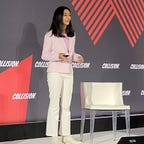Tidal: Protecting the ocean while feeding humanity sustainably
Humanity is pushing the ocean past its breaking point.
We’re 7.6 billion people who represent 0.01% of all living things, and somehow we’ve managed to destroy 83% of all wild mammals and 50% of plant life.
Not a single ocean has naturally high levels of marine wildlife anymore because we’ve impacted 87% of the oceans with our damaging actions.
See, the ocean’s are the planet’s largest ecosystem. 80% of plant diversity lives in them, and they account for 97% of our water. They produce half of the world’s oxygen too. If we lose our oceans, we lose everything.
Main problems:
- Overfishing of species (highly unsustainable)
- Greenhouse gas emissions (as climate change gets worse, the oceans get increasingly threatened)
- Pollution and dumping
- Overflowing of organic waste
To fix this problem, what we need is radical change and moonshot thinking.
What is Moonshot Thinking?
Moonshot thinking: aiming to solve a large scale global problem with an ambitious idea involving disruptive tech.
The goal is to cause a 10x impact rather than a 10% incremental change. You’re thinking 5–10 years in the future. Unlearning the status quo, and creating a brand new solution to an existing problem.
10% improvements are driven by extra effort, extra money, and extra resources. You’re looking at places others have failed & trying to do better using their method (just tweaked).
10x changes are made of being brave, thinking beyond what you know, and being creative to no limit.
(Btw here’s a way to train your moonshot thinking)
Introducing Tidal: A moonshot company at Google X
Humanity has growing protein needs, which is why we need expand ocean farming. Right now, fish farming is unsustainable. To better operate, farmers need to know more information about the health of fish, and the marine environment. The lack of knowledge about pests like sea lice and water pollution amongst farmers lead to outbreaks of disease and pollution. This is has a harmful impact for farmers and the environment.
Tidal is a moonshot company that came up with an underwater camera & machine learning system to better understand our ocean ecosystems. The goal is to use tech and help fish farmers improve feeding methods, monitoring fish health, spotting pests, and reducing waste by giving them more insight into what is happening beneath the waves at their farms.
How It Works:
- The camera & computer vision system:
- has a 360 degree visibility of the ocean, and captures the little details of the marine environment
- looks at how fish grow, identifies disease, and monitor behaviours of the fish
2. Machine learning:
- process and interprets images & videos in remote locations
3. Environmental sensors:
- collects environmental data (temperature, salinity) and identifies patterns between fish health and environment.
Tidal has created this system of sensors, cameras, and machine perception tools that are able to survive and do their job in the ocean climate. They have a data base where thousands of fish have been tracked overtime in correlation to their environmental surroundings.
By having a better understanding of our oceans, we can a) farm more sustainably and b) reverse the severe damage done to our marine environment. Google X hopes to reduce costs for farmers, while monitoring the pollution that goes into our world’s large, most inhabited ecosystem.
